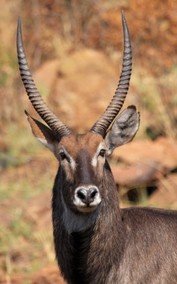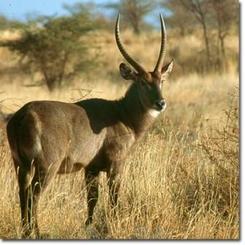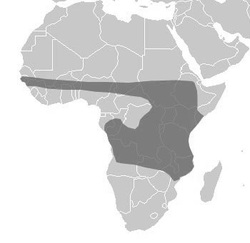Common WaterbuckKobus ellipsiprymnus |

Custom Search
|
|
The Common Waterbuck (Kobus ellipsiprymnus), is a large antelope species, that can be found in sub-Saharan Africa in Savanna grasslands, woodlands and riverine woodlands, but always near water.
They inhabit savannahs in the sub-Saharan Africa from South Africa north to Ethiopia and Sudan, west to Senegal.This habitat is perfect, because it provides sustenance, and also long grasses and watery places in which they can hide from their natural predators. To helps protect it from predators the waterbuck has the eyes located on the side of their head, this provides a great range of vision, even when they are head down grazing. Even so they fall prey to many of most predominant African predators like lions, hyenas, leopards, hunting dogs, cheetahs and crocodiles. They are also hunted for sport in Africa and are found in zoos throughout the world. There are 2 recognized subspecies the Defassa waterbuck (Kobus ellipsiprymnus defassa) but the 2 often interbreed where their bordering ranges cross. For that fact some scientists consider the two groups as a single species. The Common Waterbuck is a large, robust species, they can reach about 50 inches tall at the shoulder and weigh up to 330 to 500 pounds. The males are generally about 25 percent larger than the females. Their lifespan is about 18 years in captivity.

Their coat has a grayish-brown color that becomes darker with age. Typically they have a white crescent shaped spot on the hindquarters.
The horns, which are only present in males, are relatively long, from 50 to 100 cm in length, they are ringed and have a sickle or crescent shape. The region of the nostrils is black and has no hair. The distinctive white ring on the rump is used by females as a “follow me” signal for their calves when grazing. Both females and males will claim territories, however females won't defend it they may cross into other females ranges or wander into male ranges. Their horns can be used with lethal results when males fight one another over territories and females. The Common Waterbuck has sweat glands that produce an oily secretion believed to be used for waterproofing, but that makes for an unpleasant odor, functioning as a warning for predators to choose other prey. The Common Waterbuck species is mainly sedentary and territorial. They are most active at the beginning and end of the day. They are gregarious animals, living in herds of 5 to 30 individuals, usually led by a dominant male. Young males form bachelor groups, in which they establish hierarchical relationships. The dominance between the males of the species is based on the body size and horns and in the strength of individuals. The groups of bachelor Waterbuck males may wander over the territory of more than one dominant male and this is generally tolerated by those, although mature males are often confronted by the dominant male in that territory. There may also be herds composed solely of females. Common Waterbuck Diet They feed primarily of herbaceous plants. They drink plenty of water. The Waterbuck is a much more water-dependent species, than domestic cattle and other antelope species also present in their habitat, like the steenbok, which gets most of its water from the vegetation they eat. Common Waterbuck Reproduction Mating may occur at any time of year. The gestation period is about nine months, after which a single calf is born, rarely two, which is breastfed for six to nine months. The female hides her offspring for a period of about 3 weeks, returning several times a day to suckle it. In each suckling session the mother stays only for about 5 minutes, during which time she will clean the calf so that no odor is left to attract the predators. Even with all this care, the calf mortality rate is very high. They reach sexual maturity at one to two years of age, but males do not begin to breed at about six years old, when seeking to establish their own harem. The Common waterbuck reaches the adult weight at about 3 1/2 years. The Females will mate again very soon after giving birth, within 2 to 5 weeks, so their population can increase very rapidly. Common Waterbuck Conservation status and major threats There are an estimated total population of about 200,000, over half of which inhabit protected areas and wildlife reserves. However the population trend is decreasing for both subspecies. It is considered a least concern species according to the International Union for Conservation of Nature well the common waterbuck is but the defassa waterbuck is considered as Near Threatened. The main threats have been hunting and habitat destruction.
|
Scientific classification
Kingdom: Animalia Phylum: Chordata Class: Mammalia Order: Artiodactyla Family: Bovidae Subfamily: Reduncinae Genus: Kobus Species: K. ellipsiprymnus Subspecies K. ellipsiprymnus ellipsiprymnus K. ellipsiprymnus defassa |


